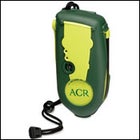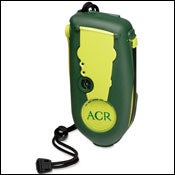I’ve used a satellite messenger, but I haven’t “used” onethat is, I havent had to send a message.
ACR Electronics TerraFix 406 PLB
 TerraFix 406 Personal Locator Beacon
TerraFix 406 Personal Locator BeaconThe SPOT certainly is an interesting concept. It uses a private satellite network to track the SPOT user’s GPS coordinates. The unit can send a signal that people back home can use to track your location on Google Maps. Or, if need be, the user can send a distress signal, with GPS coordinates, that alerts authorities to a problem. Then, voila! A big helicopter drops out of the sky and hauls your sorry ass to a hospital. Alternatively, a user can signal for “non-emergency” assistance, such as a sprained ankle that renders a user immobile but within reach of their cache of Wild Turkey and beef jerky.
Cost for the SPOT unit is $169. An emergency-only service plan is $100 a year. To add the tracking feature is another $49. So, that can add up.
The device certainly works as advertised. But, some reviewers have noted that it needs a really clear view of the sky to get out a signalsomething that may not always be easily achievable.
The alternative is a more traditional personal locator beacon. These send out an emergency-only signal and don’t have the tracking feature. That would include units such as the TerraFix 406. It’s a tough little unit that uses non-proprietary tracking technology to notify emergency workers of your location. It also sends a homing signal that brings them that last mile right to youa nice feature. It will cost you $500, but that’s a one-time cost. The ACR unit seems to have more power and more ability to “hit” a satellite than the SPOT.
Myself, I’d probably go with the ACR. I just find the SPOT’s features somewhat frivolous. Sure, it’s kind of cool that your friends can track you on Google Maps, but really, so what?
Plus, I remain wildly ambivalent about units such as this. Studies have shown that all the safety features on modern cars, such as anti-lock brakes, airbags, etc., actually convince people to push the limit more than they otherwise would. I think the same thing happens with “safety-related” outdoor gear. That has to be weighed against the fact that bad things can happen, regardless of whether we’re being careful or not.
The 2008 Summer ���ϳԹ��� Buyers Guide is now online. From riding to trail-running to camping, get reviews of nearly 400 gear must-haves.


